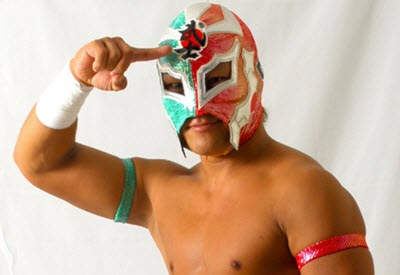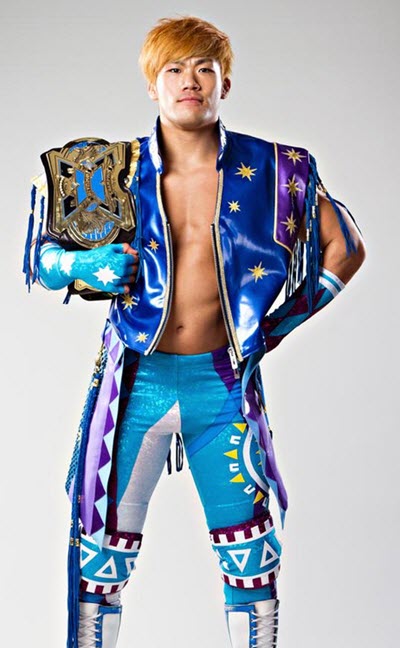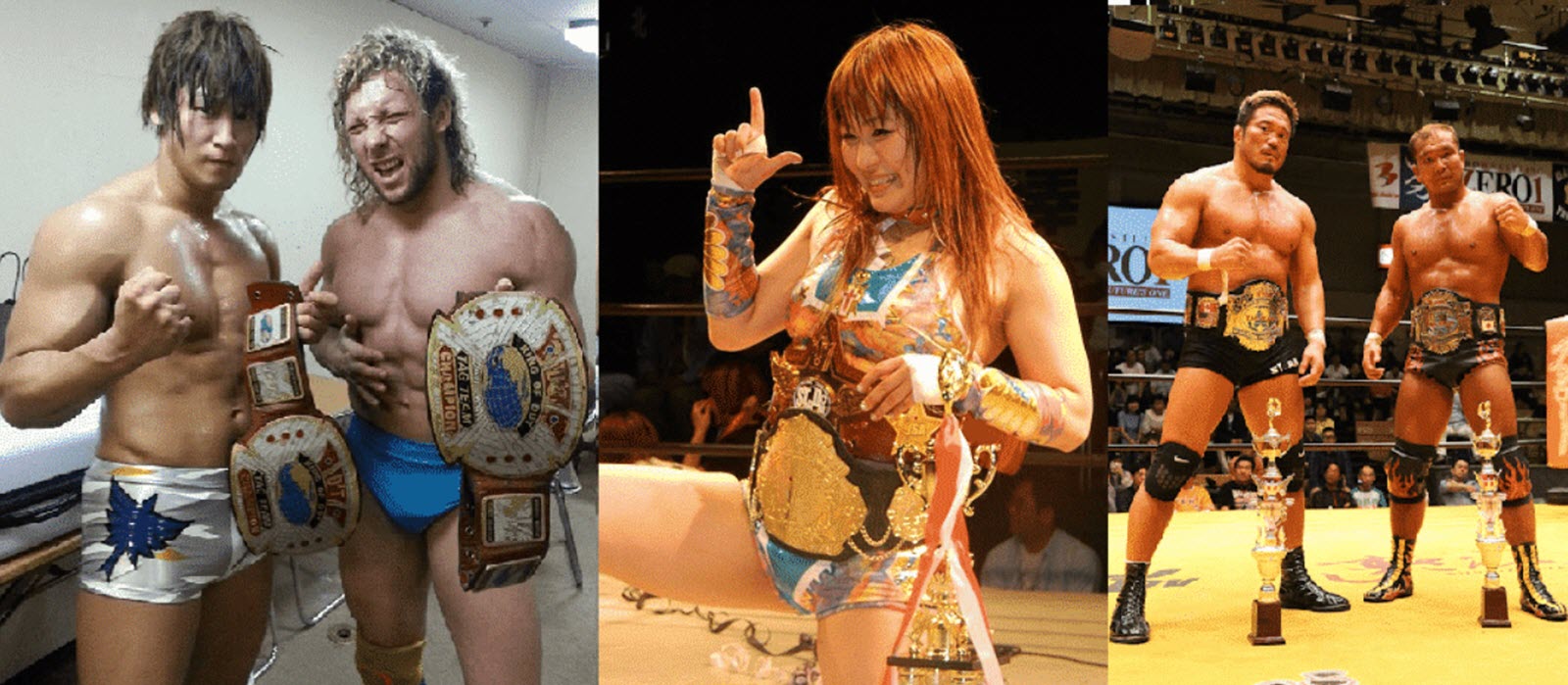Puroresu ( プロレス ) is the predominant style and gengre of professional wrestling in Japan. The name is a shortened version of the Japanese pronunciation of the English term professional wrestling.
Puroresu developed in Japan out of the traditional United States style of professional wrestling.
Most puroresu wrestlers in Japan are male, but female professional wrestlers also exist. Puroresu with female wrestlers is known as joshi puroresu ( 女子プロレス ). Joshi puroresu is typically handled by promoters specializing in joshi puroresu, rather than by the same promoters that handle male puroresu. One notable exception was Chō Sentō Puroresu FMW, which promoted both male and female wrestlers. Joshi puroresu promoters often work together with male puroresu promoters and can for instance share cards.
Style

Tetsuya Shimizu
Puroresu share many traits with United States professional wrestling, but there are also many differences. In the Japanese language, however, the word puroresu is used for all forms of wrestling, so United States professional wrestling is also called puroresu in Japan.
Generally speaking, Japanese puroresu have clean finishes and the promoters aren’t as reliant on angles or gimmicks as their U.S. counterparts. The stories told are often focused on the wrestler’s spirit and perseverance.
It is common for Japanese professional wrestlers to be at least somewhat proficiencient in several different Asian martial art techniques, and this has had an impact on the development of puroresu.
In strong style puroresu, full contact martial arts strikes and shoot submission holds are common.
Also, many puroresu promoters have strong working relationships with mixed martial arts promoters. Having wrestling matches and MMA fights on the same card is not unheard of.
NJPW & AJPW
The dominant styles of Japanese puroresu have been established by the two dominant promotions: New Japan Pro-Wrestling and All Japan Pro Wrestling.
Headed by Antonio Inoki, NJPW pushed Inoki’s “strong style” where puroresu was seen as a combat sport. This meant including plenty of kicks and strikes from matiral arts, and placing a storng focus on submission wrestling. Many of the wrestlers signed with NJPW have a solid martial arts background.
Under the direction os Shohei Baba, AJPW adopted the King’s Road style, which is more similar to U.S. style professional wrestling than NJPW’s style. King’s Road have an emphasis on holds and brawling, and storytelling is important.
Both New Japan Pro-Wrestling and All Japan Pro Wrestling are privately owned and it is not possible to invest directly in either of the wrestling leagues. Traders who want to invest in wrestling in Japan have only one option. Investing in Amuse, Inc. Amuse, Inc. is a minority owner in New Japan Pro-Wrestling and are listed on the Tokyo stock exchange. The company is relatively small with less than 300 employees.
Background

Seiya Sanada
It wasn’t until after World War II that puroresu really began to develop in the country, but the 19th century wrestler Srakichi Matsuda (1859-1891) is sometimes mentioned as an early trailblazers for what would eventually become puroresu in Japan.
In 1951, the first major star of puroresu emerged: Rikidōzan. Rikidōzan was born in Korea, but established himself as japanese post-war hero by defeating wrestlers from the United States. The U.S. Wrestlers aided Rikidōzan by portraying themselves as cheating villians. Conversely, Rikidōzan would travel to North America to wrestle and always be booked as a villian there. Rikidōzan was instrumental for popularizing puroresu in Japan and he formed the Japanese Wrestling Association (JWA). Regretably, he was murdered by the Yakuza in 1963.
Joshi
From the 1970s to the 1990s, All Japan Women’s Pro-Wrestling was dominating force within the field of joshi puroresu in Japan. Their first major stars were Mach Fumiake, Jackie Sato and Maki Ueda. The 1980s brought a second wave of starts, such as Jaguar Yokota, Devil Masami, Chigusa Nagayo and Lioness Asuka.
With the tag team “Crush Gals”, Nagayo and Asuka achieved unprecedented mainstream success in Japan and helped bring joshi puroresu into the spotlight. In the 1980s, their televised matches resulted in some of the highest rated broadcasts in Japanese television history and they often performed in sold-out arenas.
In the 1990s, joshi puroresu began attracting critical acclaim outside Japan, with wrestlers such as Akira Hokuto, Cutie Suzuki, Bull Nakano, Manami Tyotoa, Takao Inoue and Dyanmite Kansai.
Examples of professional wrestling promotions in Japan
Major promotions (male)
| English name | Location | Owners | Years active | Info |
| Japan Wrestling Association | Tokyo | Rikidōzan | 1953–1973 | Affiliated with the National Wrestling Alliance
In 1973, membership was transferred to AJPW. |
| International
Wrestling Enterprise |
Tokyo | Isao Yoshiwara | 1967–1981 | Associated with the American Wrestling Association from 1970, and the Japan Pro-Wrestling Commission with New Japan Pro Wrestling until 1981 |
| New Japan Pro-Wrestling | Tokyo | Bushiroad | 1971– | |
| All Japan Pro Wrestling | Yokohama | Jun Akiyama | 1972– | Affiliated with the National Wrestling Alliance until 1990 |
| Pro Wrestling Noah | Tokyo | Akira Taue | 2000– | |
| Dragon Gate
(Toryumon Japan 1997-2004) |
Kobe | Takashi Okamura | 2004– | |
| Inoki Genome Federation | Tokyo | Antonio Inoki | 2007– |
Major promotions (female)
| Name | Location | Owners | Years active |
| All Japan Women’s Pro-Wrestling | Tokyo | Kunimatsu Matsunaga Takashi Matsunaga |
1972–2005 |
| Gaea Japan | Tokyo | Yuka Sugiyama | 1995–2005 |
Independent promotions (male)
| Name | Location | Owners | Years active | Info |
| Universal Wrestling Federation | Matsumoto | Hisashi Shinma | 1984–1986 | Revived as the Newborn UWF in 1988 and again in 1991 as Union of Wrestling Forces International (UWF International or UWFi). |
| Pioneer Senshi | Tokyo | Ryuma Go Apollo Sugawara Masahiko Takasugi |
1988–1991 | First-ever independent promotion in Japan. |
| Cho Sento Puroresu FMW | Greater Tokyo Area | Akihito Ichihara Yukihide Ueno |
1989–2002 2015- |
Formerly named Frontier Martial Arts Wrestling. |
| Super World of Sports | Tokyo | Hachiro Tanaka | 1990–1992 | Associated with the World Wrestling Federation. |
| Federacion Universal de Lucha Libre | Hisatsune Shinma | 1990–1995 | Known as Universal Pro Wrestling from 1990 to 1993, the promotion was affiliated with the Universal Wrestling Association. | |
| Wrestling International New Generations | Tokyo | Kiyoshi Ibaragi Victor Quiñonez |
1991–1994 | Associated with the World Wrestling Council. |
| Pro Wrestling Fujiwara Gumi | Tokyo | Yoshiaki Fujiwara Masakatsu Funaki Minoru Suzuki |
1991–1995 | |
| UWF International | Tokyo | Nobuhiko Takada | 1991–1996 | Continuation of Universal Wrestling Federation. |
| Fighting Network Rings | Tokyo | Akira Maeda | 1991–2002 | Continuation of Newborn UWF.
Revived as the The Outsider series in 2008, a promotion for mixed martial arts. |
| Wrestle Association “R” | Tokyo | Gen’ichiro Tenryu Masatomo Takei |
1992–2006 | |
| Michinoku Pro Wrestling | Morioka | Great Sasuke | 1993– | |
| Union Pro Wrestling | ShinjukuTokyo | Naomi Susan DDT Pro Wrestling |
1993–1995 2004–2015 |
|
| Tokyo Pro Wrestling | Tokyo | Takashi Ishikawa | 1994–1996 | |
| Kokusai Promotion | Chigasaki | Goro Tsurumi | 1994–2007 | Formerly known as I.W.A. Named Kakutoushijuku from 1994 to 1998.
The original IWA World Heavyweight Championship was later revived by the promotion. |
| IWA Japan | Tokyo | Tatsukuni Asano | 1994–2014 | Continuation of W*ING. |
| Big Japan Pro Wrestling | Yokohama | Shinya Kojika | 1995– | |
| Battlarts | Koshigaya | Yuki Ishikawa | 1996–2011 | |
| Pro Wrestling Kageki | Fukuoka | Azteca | 1997– | |
| DDT Pro-Wrestling | Tokyo | Sanshiro Takagi | 1997– | |
| Kingdom | Tokyo | 1997–1998 | Continuation of UWF International | |
| Osaka Pro Wrestling | Osaka | Yuji Sakagami | 1998– | |
| Pro Wrestling Zero1 | Tokyo | First On Stage Inc. | 2001– | |
| Kaientai Dojo | Tokyo | Taka Michinoku | 2002– | |
| World Entertainment Wrestling | Tokyo | Hiromichi Fuyuki | 2002–2008 | |
| 666 | Tokyo | Crazy SKB Onryo |
2003– | |
| Wrestling Marvelous of the Future | Tokyo | Eiji Ezaki Masashi Honda |
2003–2005 | |
| Diamond Ring | Yoshikawa | Kensuke Sasaki Akira Hokuto |
2003–2013 | Formerly named Kensuke Office |
| Guts World Pro Wrestling | Tokyo | Guts Ishijima | 2004– | |
| Big Mouth Loud | Tokyo | Fumihiko Uwai Kazunari Murakami |
2004–2006 | |
| Riki Pro | Tokyo | Riki Choshu Katsuji Nagashima |
2004–2010 | Also known as World Japan Pro Wrestling (WJPW) or Fighting of World Japan |
| Hustle | Greater Tokyo Area | Nobuhiko Takada | 2004–2011 | |
| STYLE-E Pro Wrestling | Tokyo | Kazuhiro Tamura Masato Shibata |
2004–2012 | |
| Apache Pro-Wrestling Army | Tokyo | Kintaro Kanemura | 2004–2016 | |
| Real Japan Pro Wrestling | Tokyo | Satoru Sayama | 2005– | |
| Fu-Ten | Fukuoka | Daisuke Ikeda | 2005– | |
| El Dorado Wrestling | Tokyo | Noriaki Kawabata Koji Fujinaga |
2006–2008 | Continuation of DragonDoor |
| VKF Puroresu | Osaka | Toshiyuki Kawamura | 2007– | |
| Dradition | Tokyo | Tatsumi Fujinami | 2008– | |
| Okinawa Pro Wrestling | Naha, Okinawa | Super Delfin | 2008–2012 | |
| Secret Base | Tokyo | Mototsugu Shimizu Jun Ogawauchi |
2009– | Continuation of El Dorado Wrestling |
| Pro Wrestling Freedoms | Tokyo | Takashi Sasaki | 2009– | |
| Tokyo Gurentai | Tokyo | Nosawa Rongai Mazada |
2010– | |
| Smash | Tokyo | Yoshihiro Tajiri Akira Shoji |
2010–2012 | Continuation of Hustle |
| Tenryu Project | Tokyo | Genichiro Tenryu | 2010–2015 | |
| Legend The Pro Wrestling | Tokyo | Tatsumi Fujinami Riki Choshu Shodai Tiger Mask |
2011– | |
| Wrestling New Classic | Tokyo | Yoshihiro Tajiri | 2012–2014 | Continuation of Smash.
Sister promotion of Reina Joshi Puroresu |
| Wrestle-1 | Tokyo | Keiji Mutoh | 2013– | |
| Ryukyu Dragon Pro Wrestling | Kadena | Gurukun Mask | 2013– | |
| Pro Wrestling Heat Up | Tokyo | Kazuhiro Tamura | 2013– | Continuation of Style-E Pro Wrestling |
| Doutonbori Pro-Wrestling | Osaka | Doutonbori Entertaniment Systems | 2013– | |
| Ōdō | Tokyo | Akebono | 2015- | |
| Pro-Wrestling Basara | ShinjukuTokyo | Isami Kodaka | 2015– | Continuation of Union Pro Wrestling |
| Diamond Stars Wrestling | Tokyo | Hideo Shimada | 2016– |
Independent promotions (female)
| Name | Location | Owners | Years active | Info |
| Japan Women’s Pro-Wrestling | Tokyo | Jackie Sato | 1986–1992 | Affiliated with Universal Wrestling Association
In 1992, the promotion split into two groups: the JWP Project and Ladies Legend Pro Wrestling. |
| Ladies Legend Pro-Wrestling | Tokyo | Rumie Kazama Shinobu Kandori |
1992– | |
| JWP Joshi Puroresu | Tokyo | Kiyoshi Shinozaki Masatoshi Yamamoto |
1992–2017 | |
| Jd’ | Tokyo | Yoshimoto Kogyo Company J Office Group |
1995–2007 | |
| Arsion | Tokyo | Hiroshi Ogawa | 1997–2003 | |
| Oz Academy | Tokyo | Mayumi Ozaki | 1998– | |
| NEO | Kawasaki | Tetsuya Koda | 1998–2010 | |
| Major Girl’s Fighting AtoZ | Tokyo | Mariko Yoshida Yumiko Hotta |
2003–2006 | Continuation of Arsion |
| Sendai Girls’ Pro Wrestling | Sendai | Meiko Satomura | 2005– | |
| Ibuki | Tokyo | Mariko Yoshida | 2005–2010 | |
| Ice Ribbon | Warabi | Neoplus | 2006– | |
| Pro Wrestling Sun | Tokyo | First On Stage Inc. (FOS) | 2006–2009 | Sister promotion of Pro Wrestling Zero1 |
| Pro Wrestling Wave | Tokyo | Zabun Co, Ltd. | 2007– | Sister promotion of Osaka Joshi Pro-Wrestling |
| Stardom | Tokyo | Rossy Ogawa | 2010– | |
| Osaka Joshi Pro Wrestling | Osaka | Zabun Co, Ltd. | 2010–2017 | Sister promotion of Pro Wrestling Wave |
| Diana | Kawasaki | Kyoko Inoue | 2011– | |
| Reina Joshi Puroresu | Chiba | Hideaki Hatakeyama | 2012– | Sister promotion of Wrestling New Classic |
| World
Pro-Wrestling Association |
Tokyo | Aki Kanbayashi | 2013– | |
| Marvelous | Funabashi | Chigusa Nagayo | 2014– | |
| Pure-J | Command Bolshoi | 2017– |
This article was last updated on: June 5, 2018
